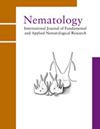来自伊朗的佩德拉米鼠的描述和分子特征
IF 1.2
4区 生物学
Q2 ZOOLOGY
引用次数: 0
摘要
从伊朗西南部胡齐斯坦省的枣椰树根际土壤中发现的diylenchus pedrami n. sp,根据形态和分子数据进行了描述和说明。该新种的特征是:侧场有6条线,唇部与体轮廓光滑连续,花柱长9 ~ 11 μm,咽球中部椭圆形,瓣小,咽球与肠偏置,V = 83.9(80.2 ~ 88.1),尾圆锥形,尖部钝或圆,雄体有20.1 (17 ~ 24)μm长的针尖。在形态上,这一新种与D. africanus、D. anchilisposomus、D. australiae、D. clarus、D. clavicaudatus和D. parcevivens很接近,主要是由于它们具有共同的特征,如侧边的六条线、花柱长度和有点相似的尾端。并将新种与与之有密切亲缘关系的stenurus和sarvarae进行了比较。利用小亚基的部分序列、大亚基的D2-D3扩展段和核糖体DNA (SSU、LSU D2-D3和ITS rDNA)的内部转录间隔区,基于贝叶斯推理(BI)对新种与Anguinidae科代表物种的系统发育关系进行了重构和讨论。本文章由计算机程序翻译,如有差异,请以英文原文为准。
Description and molecular characterisation of Ditylenchus pedrami n. sp. (Rhabditida: Anguinidae) from Iran
Ditylenchus pedrami n. sp., recovered from the rhizospheric soil of date palm in Khuzestan province, southwest Iran, is described and illustrated based upon morphological and molecular data. The new species is characterised by having six lines in the lateral field, lip region smooth and continuous with body contour, stylet 9-11 μm long, median pharyngeal bulb oval with small valve, pharyngeal bulb offset from the intestine, V = 83.9 (80.2-88.1), conoid tail with a pointed, dull or rounded tip and males with 20.1 (17-24) μm long spicules. Morphologically, the new species comes close to D. africanus, D. anchilisposomus, D. australiae, D. clarus, D. clavicaudatus and D. parcevivens, mainly by having shared features like six lines in the lateral fields, stylet length and somewhat similar tail tip. The new species was also compared with D. stenurus and D. sarvarae, two species with close phylogenetic affinities to it. The phylogenetic relationships of the new species with representatives of the family Anguinidae were reconstructed and discussed using partial sequences of the small subunit, D2-D3 expansion segments of the large subunit, and internal transcribed spacer regions of ribosomal DNA (SSU, LSU D2-D3 and ITS rDNA) based on Bayesian inference (BI).
求助全文
通过发布文献求助,成功后即可免费获取论文全文。
去求助
来源期刊

Nematology
生物-动物学
CiteScore
2.60
自引率
33.30%
发文量
67
审稿时长
3 months
期刊介绍:
Nematology is an international journal for the publication of all aspects of nematological research (with the exception of vertebrate parasitology), from molecular biology to field studies. Papers on nematode parasites of arthropods, and on soil free-living nematodes, and on interactions of these and other organisms, are particularly welcome. Research on fresh water and marine nematodes is also considered when the observations are of more general interest.
Nematology publishes full research papers, short communications, Forum articles (which permit an author to express a view on current or fundamental subjects), perspectives on nematology, and reviews of books and other media.
 求助内容:
求助内容: 应助结果提醒方式:
应助结果提醒方式:


